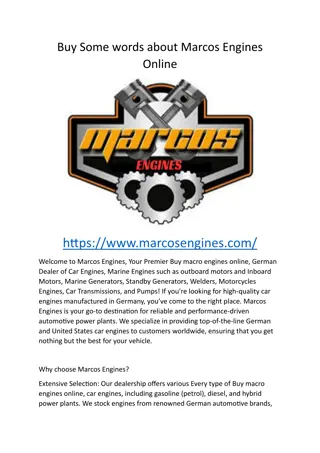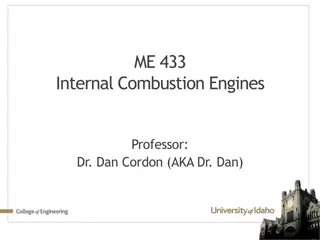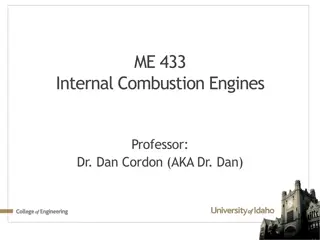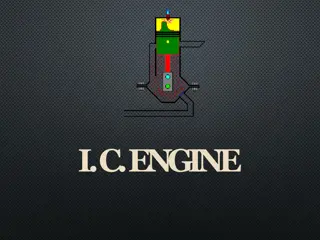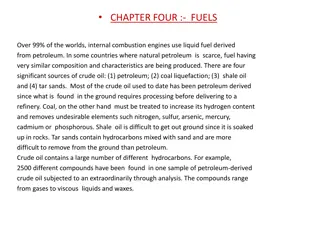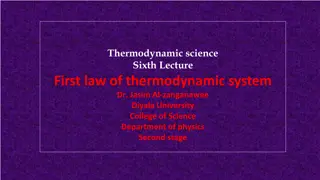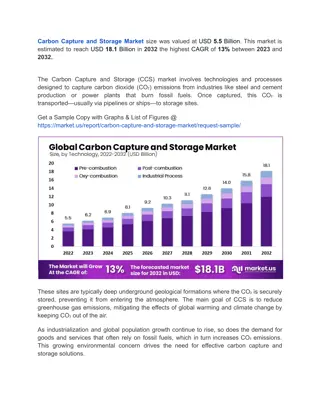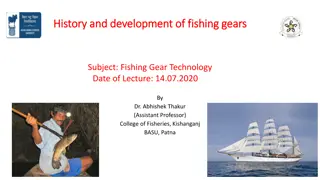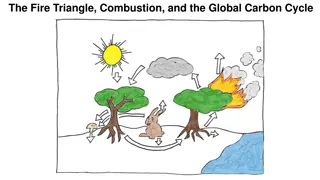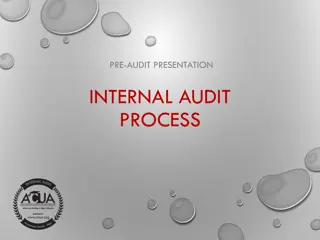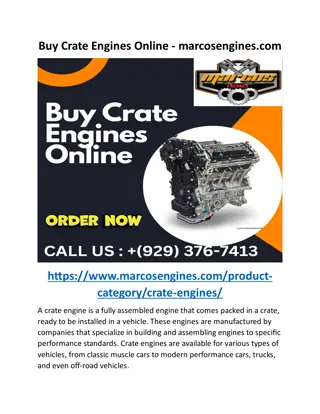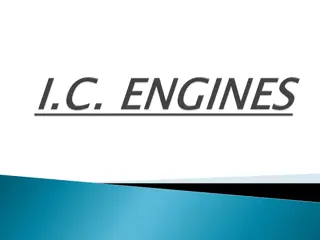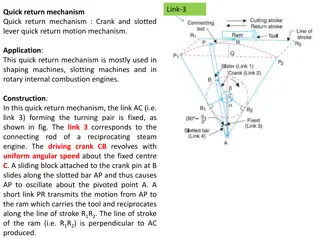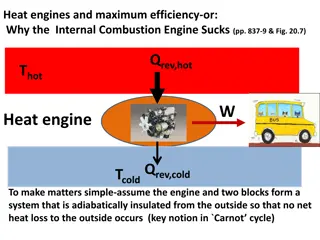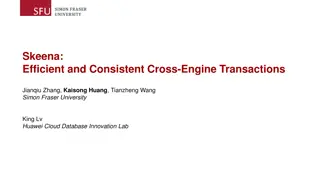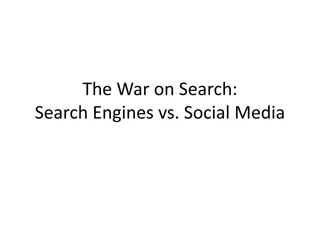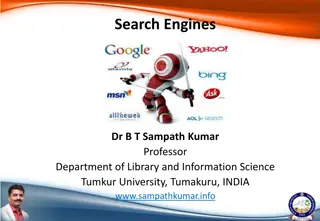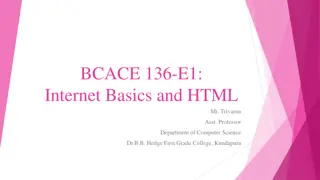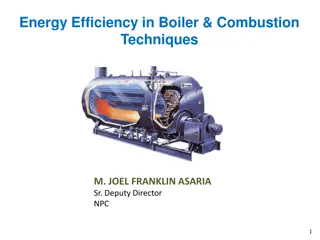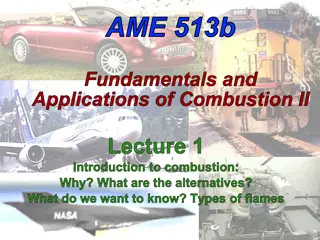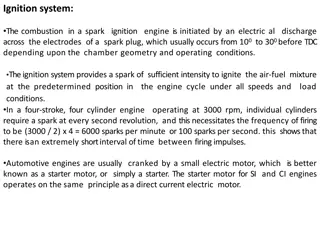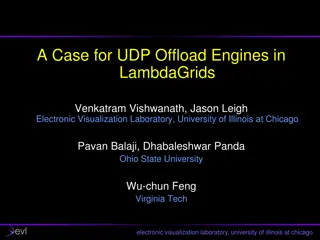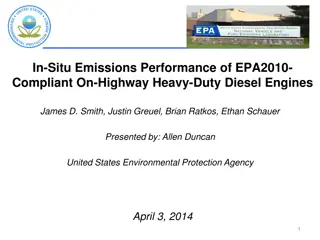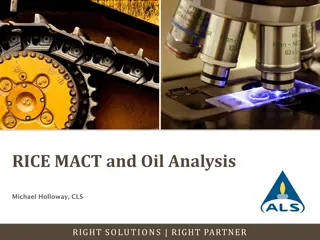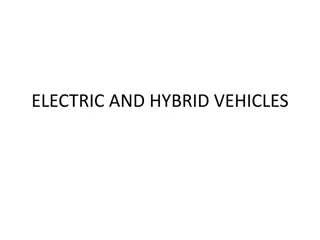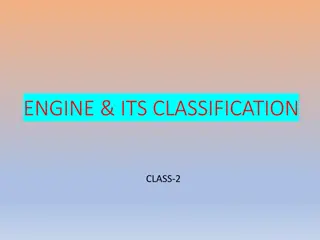Advancements in Hydrogen Combustion for Internal Combustion Engines
Exploring the utilization of hydrogen as a sustainable fuel for internal combustion engines, this research delves into the mixing, combustion, and particulate formation processes in H2ICE. Discussions cover the benefits of hydrogen, challenges faced, and innovative solutions like onboard on-demand h
0 views • 21 slides
Advancing Space Exploration Through Nuclear Thermal Propulsion Engine Technology
The article discusses the development, testing, and challenges of Nuclear Thermal Propulsion (NTP) engines for space exploration. It covers the history, components, and benefits of NTP engines, as well as the specific engineering considerations and advancements in this field. The content emphasizes
6 views • 20 slides
Buy Some words about Marcos Engines Online
Welcome to Marcos Engines, Your Premier Buy macro engines online, German Dealer of Car Engines, Marine Engines such as outboard motors and Inboard Motors, Marine Generators, Standby Generators, Welders, Motorcycles Engines, Car Transmissions, and Pumps! If you\u2019re looking for high-quality car en
6 views • 3 slides
Understanding Fuel Chemistry in Internal Combustion Engines
Fuel chemistry knowledge is crucial for internal combustion engines for various reasons such as determining air-fuel ratios, ensuring efficient combustion, preventing detonation, and optimizing power output. Balancing chemical equations, calculating specific volume for mixtures, and analyzing first
10 views • 19 slides
Understanding Mean Effective Pressure in Internal Combustion Engines
Mean Effective Pressure (MEP) is a crucial parameter in internal combustion engines, representing the average pressure exerted on the piston during the power stroke. MEP is relatively consistent for specific engine types, making it a useful predictor of torque output based on engine type and displac
10 views • 20 slides
Electric powertrain
The Electric Powertrain Market investigates the global shift towards electric propulsion systems in vehicles. It analyzes trends in electric motors, batteries, and power electronics driving the transition from internal combustion engines to electric powertrains.
0 views • 7 slides
Understanding Internal Combustion Engines: A Comprehensive Overview
Explore the intricate world of Internal Combustion Engines (I.C. Engine), including their classification, components, terminology, and operation cycles. Delve into the various types, arrangements, and applications of I.C. engines, from automobiles to aircraft engines, and uncover the key principles
1 views • 25 slides
Understanding Engine Cooling Systems
The cooling system in an engine is vital for maintaining optimal operating temperatures, preventing overheating, and ensuring efficient combustion. There are different types of cooling systems such as air cooling and liquid cooling, each with its advantages and disadvantages. Air-cooled engines rely
0 views • 23 slides
Understanding Balancing of Reciprocating Masses in Engines
Learn about the balancing of reciprocating masses in engines, including the importance of balancing primary and secondary forces in multi-cylinder in-line engines. Discover how crank angles and cylinder arrangements contribute to balancing forces for optimal engine performance.
0 views • 6 slides
Understanding Fuels and Their Sources
Fuels derived from petroleum, coal, shale oil, and tar sands are crucial for powering internal combustion engines. Crude oil contains various hydrocarbons requiring refining processes to obtain products like natural gas, gasoline, kerosene, diesel oils, fuel oils, and lubricating oils. The chemical
1 views • 7 slides
Understanding the First Law of Thermodynamics in Science Lectures
Explore the concept of the First Law of Thermodynamics through a series of engaging science lectures by Dr. Jasim Al-zanganawee from Diyala University. Learn about energy transfer, conservation, internal energy of ideal gases, and how heat and work impact a system's total energy. Discover the relati
0 views • 15 slides
High Costs and Safety Issues Challenge Carbon Capture and Storage Adoption
Carbon Capture and Storage Market By Technology (Pre-combustion, Post-combustion, Oxy-combustion, and Industrial Process), By End-Use Industry (Power Generation, Oil & Gas, and Other End-Use Industries), By Region and Companies \u2013 Industry Segmen
0 views • 4 slides
Impact of Data Analytics and Consulting Activities on Internal Audit Quality
This research examines how the use of data analytics and consulting activities affect perceived internal audit quality. The study investigates the relationship between these factors and top management's perception of internal audit quality. Through online scenario-based experiments with middle and t
2 views • 11 slides
Evolution of Fishing Gear Technology: From Traditional Methods to Modern Innovations
Fishing has evolved from a traditional practice to an industrial activity with advancements in fishing gear, vessels, and preservation techniques. Mechanization, starting in the 19th century, led to the use of steam, internal combustion engines, and eventually diesel and electrical/hydraulic systems
2 views • 9 slides
Understanding the Fire Triangle, Combustion, and the Global Carbon Cycle
This series of images explores the concepts of the fire triangle, combustion, and the global carbon cycle. It delves into the role of oxygen, fuel, and heat in combustion processes, leading to the production of carbon dioxide, water, heat, and light. The images further illustrate the chemical proces
1 views • 12 slides
Understanding Internal Audit and Controls Process
This content provides an overview of the pre-audit presentation, objectives of the presentation, the definition of internal audit, the role of internal audit in examining university departments, the university audit process, internal audit reporting lines, and insights on internal controls in an org
3 views • 30 slides
Buy Crate Engines Online - marcosengines.com
A crate engine is a fully assembled engine that comes packed in a crate, ready to be installed in a vehicle. These engines are manufactured by companies that specialize in building and assembling engines to specific performance standards. \nText\/ Wh
1 views • 3 slides
Understanding Energy Conversion in Steam Engines
Explore the energy conversion processes in steam engines, learn about fossil fuels like coal, oil, and natural gas, and discover the composition of fossil fuels. This lesson covers the operation of steam engines, energy changes, advantages, and disadvantages, providing a comprehensive overview of en
2 views • 14 slides
Overview of Internal Combustion Engines and Their Components
Internal combustion engines are devices that convert fuel's chemical energy into thermal energy, which is then used to produce mechanical work. The engines can be classified into two types - External Combustion Engines and Internal Combustion Engines. Internal combustion engines include components l
2 views • 53 slides
Understanding Quick Return Mechanism in Machinery
Exploring the application, construction, and velocity analysis of the crank and slotted lever quick return motion mechanism commonly used in shaping machines, slotting machines, and rotary internal combustion engines. The mechanism involves fixed link AC, driving crank CB, sliding block, and short l
8 views • 14 slides
Understanding Heat Engines and Engine Efficiency
Exploring the concept of heat engines and maximizing efficiency, specifically examining why internal combustion engines have limitations. The discussion covers reversible heat transfer, engine work, efficiency calculations, and practical application to car engines. Insights on temperature differenti
0 views • 4 slides
Understanding Small Gasoline Engine Performance
This chapter explores the intricacies of measuring and optimizing internal combustion engine performance, focusing on calculating functional horsepower through various formulas and measurements. It delves into the combustion process in a small gasoline engine, detailing how the air/fuel mixture igni
0 views • 66 slides
Understanding the Components and Operation of Internal Combustion Engines
Dive into the world of internal combustion engines through a detailed exploration of their classification, key components like cylinders, pistons, crankshafts, and crankcases, as well as the operational principles of four-stroke engines. Discover how these engines work, their construction, and the r
2 views • 103 slides
Efficient Cross-Engine Transactions in Skeena
Skeena presents efficient and consistent cross-engine transactions, offering solutions to challenges faced by traditional database engines. By utilizing memory-optimized database engines and a multi-engine DBMS approach, Skeena addresses issues such as high costs and compatibility concerns associate
2 views • 21 slides
Understanding Generalized Heat Engines and Carnot Cycle
Generalized heat engines can be reversible or irreversible, with Carnot engines playing a crucial role in maximizing efficiency. By analyzing the heat absorption and rejection processes, we explore the impact of multiple tiny Carnot engines working together and the overall effect on the main general
0 views • 14 slides
The Battle Between Search Engines and Social Media
In the ongoing debate of Search Engines vs. Social Media, the focus is on visibility for businesses and products. While search engines excel in catering to our search habits and providing accurate results, social media offers peer recommendations, real-time responses to criticism, and immediate avai
0 views • 7 slides
Understanding Search Engines and Their Importance
Search engines, such as Google, play a crucial role in retrieving information from the web, providing access to a vast document collection, and helping users find what they need quickly and efficiently. They come in different types like robot-driven and meta search engines, each serving specific pur
1 views • 23 slides
Understanding Search Engines: Internet Basics and How to Search Effectively
The internet is a vast source of information, however, finding relevant content can be challenging. Search engines play a crucial role in navigating this vast space by indexing web pages and providing users with results based on relevance. This article explores the components of search engines, how
0 views • 8 slides
Analysis of Emergency Engines and Ozone Levels in Demand Response Events
Use of emergency engines in demand response (DR) events does not correlate with high ozone levels, as shown by a study conducted from 2005 to 2011 across various regions like PJM, ISO NE, NYISO, and ERCOT. The analysis reveals that emergency DR events do not align with high ozone days, indicating no
0 views • 12 slides
Energy Efficiency in Boiler & Combustion Techniques
This article discusses energy efficiency in boiler systems and combustion techniques, covering topics such as boiler types, classifications, specifications, and applications. It explains the process of heat generation through fuel combustion, transfer to water for steam production, and highlights va
0 views • 70 slides
Fundamentals of Combustion II - Introduction and Nomenclature
This lecture introduces the fundamentals of combustion by discussing reasons for studying combustion, alternative energy sources, and what we aim to understand. It covers different types of flames and provides a comprehensive nomenclature summary for the course, including various parameters and thei
0 views • 32 slides
Understanding the Ignition System in Internal Combustion Engines
The ignition system in spark ignition engines initiates combustion through electric discharge across the spark plug electrodes. It ensures proper ignition timing for efficient engine operation at various speeds and loads. Modern ignition systems include battery, magneto, and electronic ignition type
0 views • 21 slides
Optimizing Real-Time Data Delivery with UDP Offload Engines in LambdaGrids
Real-time interactive scientific visualization and high-definition video conferencing in large-scale visualization environments like LambdaGrids require high-throughput, low latency, and low jitter data delivery. This article discusses the motivation behind using UDP-based transport protocols and th
0 views • 12 slides
Understanding Internal Auditing: Role and Importance
Internal Audit Department exists to provide independent assurance, consulting services, and improve operations by evaluating risk management, internal controls, and governance processes. It reports to the campus president and the Director of System-wide Internal Audit at TBR while serving the colleg
0 views • 7 slides
Ensuring Compliance and Performance of EPA2010-Compliant Heavy-Duty Diesel Engines
This documentation explores the in-situ emissions performance of EPA2010-compliant heavy-duty diesel engines, focusing on compliance goals, demonstrating compliance through test cycles, and in-use testing program goals. It discusses the importance of verifying compliance, forecasting, certification,
0 views • 14 slides
Understanding How Browser Engines Work
Browser engines play a crucial role in how web browsers retrieve, present, and traverse information resources on the World Wide Web. This process involves fetching a page, interpreting URLs, rendering content with layout engines, and utilizing components like the host application. Popular layout eng
0 views • 10 slides
Understanding RICE MACT and its Impact on Air Quality
The RICE MACT (Maximum Achievable Control Technology) regulation aims to reduce emissions of Hazardous Air Pollutants (HAPs) from reciprocating internal combustion engines. It applies to major industrial sources emitting significant amounts of HAPs and outlines emission requirements for different ty
0 views • 26 slides
Understanding Electric and Hybrid Vehicles: Hybridization and Interdisciplinary Aspects
Electric and hybrid vehicles (HEVs) feature different hybridization ratios based on the power rating of their electric motors. Concepts like full hybrid, mild hybrid, and micro hybrid define the extent of electric motor usage for driving. HEVs involve a mix of electric machines, power electronics, b
0 views • 50 slides
Understanding Engine Classification and Design
Engine classification involves categorizing engines based on various factors such as combustion type, number of strokes, cylinder design, and ignition method. Common classifications include external and internal combustion engines, as well as categories based on the design and use of the engine. Add
0 views • 11 slides
Understanding Variable Valve Timing (VVT) in Internal Combustion Engines
Variable Valve Timing (VVT) optimizes engine performance by adjusting valve duration, timing, and lift according to engine speed, enhancing torque, power, and fuel efficiency. VVT operates by varying intake valve opening/closing, regulating valve timing, and adjusting lift for better volumetric effi
0 views • 14 slides


